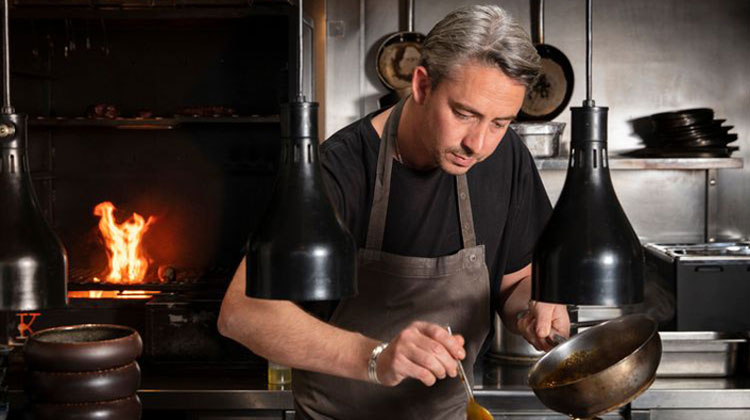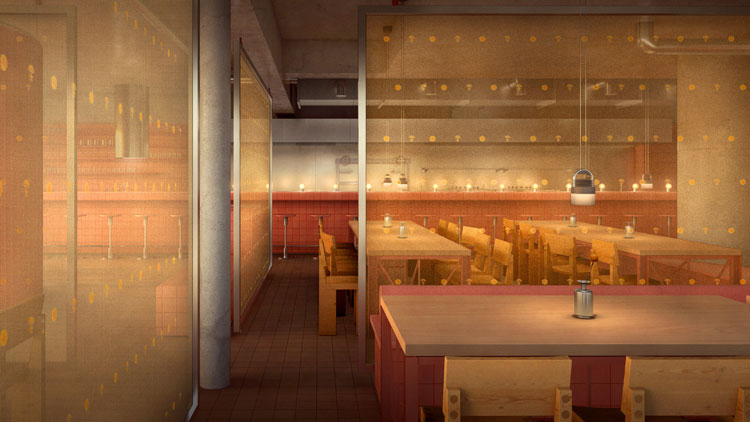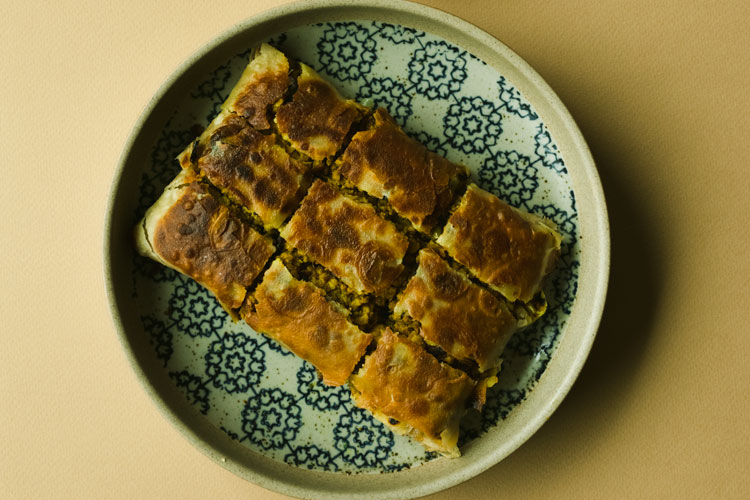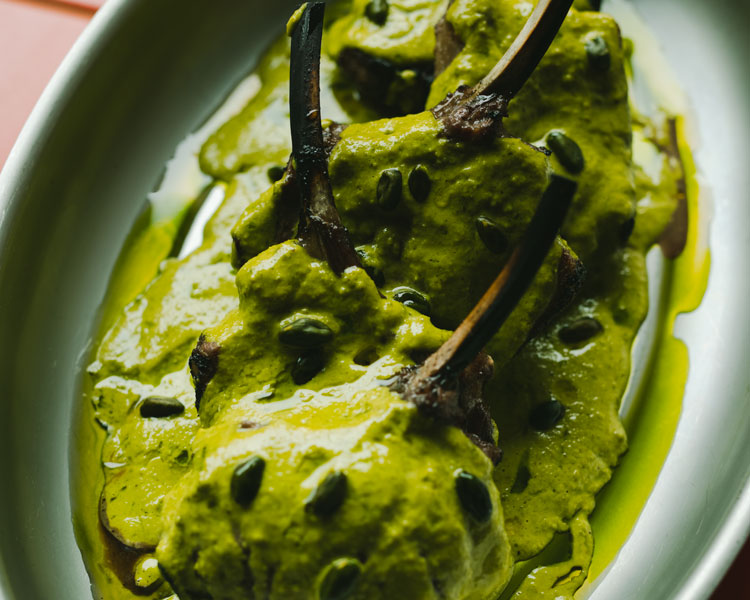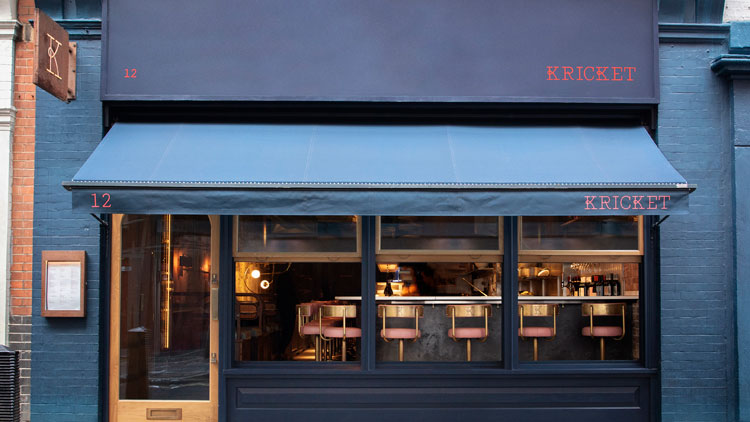You know the feeling. You wait six years for one restaurant site to come along and then suddenly, you’re opening two in the space of a matter of months. Such is the story with Kricket, the modern Indian restaurant group founded by friends Rik Campbell and Will Bowlby. No sooner has the paint dried on the pair’s new restaurant in Canary Wharf, which opened at the start of the month and marked their first new restaurant opening since 2018, their thoughts have turned to another project in Shoreditch, with plans for it to open before the year is through.
Bringing to life multiple sites within a short time frame is not unusual in the world of restaurants – Jeremy King’s Arlington and The Park opening mere months apart being a recent example – but with Kricket the way they came about couldn’t be more different. With Canary Wharf the pair say they took some convincing to even go and visit the area, while the Shoreditch site, previously home to Apothecary East just off Great Eastern Street, was an opportunity “too good to turn down”. Yet here they are, almost doubling the size of their restaurant estate as a result.
Campbell and Bowlby meet me in their Soho restaurant, their smash hit of a venue that opened back in 2016, to talk expansion. The pair haven’t exactly been idle since their last new restaurant opening in White City in 2018 having launched SOMA, their modern and minimalist take on a basement speakeasy, next to their Soho site in the autumn of 2021, but there is a sense that they are embarking on a new chapter for the brand that originated as a pop-up in Pop Brixton in 2015. Late last year the business secured a new round of funding from its backer White Rabbit Projects, alongside an injection of cash from Campbell and Bowlby themselves and, following a trip to India at the start of the year, menus have been overhauled across the estate. Add in a bit of a rebrand and a slick new website and new social media direction and the Kricket of today is very much an evolved beast.
“We had a look at our branding, made some tweaks, and elevated the offer a bit more,” says Campbell of the changes. “As part of our brand identity we have dropped the ‘Indian inspired cooking’ description on the website (Kricket now describes itself as serving ‘modern Indian cooking’). We felt like we were tiptoeing around the fact that we were an Indian restaurant run by two white guys when actually we don’t need to. We are an Indian restaurant.”
“We were almost apologetic about it before,” adds Bowlby, who oversees the food side of things at Kricket. “But almost all of the kitchen team is Indian or Nepalese.”
Recent changes have extended beyond branding with the trip to India inspiring a change of tack with the menu. “We were more rigid in our structure,” says Bowlby. “We did four or five big wholesale changes to the menu each year, half the menu at the time. But we went to Mumbai and other places and came back with slightly new direction and a tank full of ideas.”
In February the pair changed around 80% of the menus across the estate, which Bowlby describes as a “pretty mega” thing to do. “As a result, rather than do massive changes we will now make smaller changes more often,” he says. “We are not restricted by these deadlines because it doesn’t always work like that. The weather has so much impact on what produce is available so we have got to be a little bit more flexible, particularly with prices going up.”
The pair have also responded to the current climate with the introduction of a new pricing and menu structure. Menus are now divided into snacks, starting from £2.50, smaller and larger plates (from £8-£16) and sides and tandoor dishes, but there’s also a number of more expensive specials on offer – a Keralan market fish curry (£35) and 600g beef sirloin (£60) are available at Soho; Canary Wharf has a grilled mutton chop pistachio qorma (£48) on the menu, and Brixton a tandoori poussin (£28). “The idea is to allow people to spend less and also give them the opportunity to spend more,” says Campbell. “It’s all a bit more grown up.”
The six-year itch
This more grown-up restaurant group seems ripe for expansion, and this is exactly what Campbell and Bowlby are now pursuing. While six years might seem a long time between restaurant openings, there is the small matter of the Covid years to consider, followed by the cost-of-living crisis, both of which have hampered Kricket’s progress.
A site in Borough Yards was nearly signed on but the pair eventually pulled out, citing the combination of falling out of love with the location and the wrong timing (“it was too early doors for that development,” says Campbell).
“Covid has presented plenty of opportunities. There are sites in places you may have once paid a premium on that landlords will now pay you to go into, but it’s been about waiting for the right site rather than being overwhelmed by what’s available,” says Bowlby. “Covid is still having an effect on our industry so the need to make sensible decisions is vital.”
Enter Canary Wharf, a burgeoning area of the London that the pair admit was not high on their list of prime locations. “Will and I hadn’t been to Canary Wharf for about 10 years, we had a stereotypical opinion of it,” says Campbell. “If you’d asked us two years ago if we’d consider Canary Wharf, we’d have laughed but we were ignorant to the changes that had been going on over there.”
The pair were initially approached to look at a former showroom in Wood Wharf but turned it down but were drawn to the area’s North Dock where chophouse group Blacklock had recently opened directly beneath the DLR line. The site had originally been taken by Nightcap for a new bar concept and had a late licence, which had additional appeal when considering putting a second SOMA into the site.
“We wouldn’t have looked at it if Gordon [Ker, Blacklock’s founder] wasn’t next door,” admits Campbell. “We think of ourselves as being similar to Blacklock in being affordable for our cuisine. It is only round the corner from us in Soho as well, so it seemed perfect. We have a similar average spend (Kricket’s is £42 – £48 at dinner and £38 at lunch) and we complement each other. Gordon’s the one that made the bold move taking the site on and we’ve followed.”
A punt on Canary Wharf
Canary Wharf is Kricket’s biggest site by square footage to date and comprises an 85-cover restaurant and SOMA, a 50-cover bar. As with Soho, both concepts complement each other but operate as separate entities with their own entrances, SOMA acting as a place to which restaurant diners can retire but also as a standalone cocktail bar.
“We don’t want to create a situation where you walk into Kricket and see SOMA in the corner,” says Campbell. “They are separate concepts but are just in the same building. If we can find situations where we can do both in the same building or across the road from each other that’s a nice touch.”
“Operationally, it really benefits them being next to each other because we have a captive audience,” says Bowlby, who adds that the restaurant has a simplified cocktail list “because you can have everything you want next door at SOMA”.
“Covid is still having an effect
on our industry so the need to
make sensible decisions is vital”
Design wise, Canary Wharf is markedly different from its sister restaurants. The space is even more stripped back than its siblings and has a terracotta floor, red tiled walls and orange blinds that break up seating areas. The dining room is dominated by a long counter bar at which people can sit and eat and watch the chefs cook, including on a charcoal grill and tandoor due to gas cooking being prohibited.
“It is convenient because I like cooking on charcoal,” says Bowlby, “but a charcoal tandoor is a first for us. It’s probably the thing I’m most nervous about because controlling that is a different beast to the gas ones we use in the other restaurants.”
The menu at Canary Wharf reflects the use of the grill, with around 11 new dishes that include the aforementioned mutton chop qorma – a silver platter piled with mutton chops laced with a vibrant thick green sauce; squid stuffed with Goan sausage biryani; a pork neck curry; a slowly-grilled Himalayan-style trout; and a rabbit keema baida roti (pictured below).
“Whether it be in the preparation of the food or the finishing the focus of the food will be much more about the grill,” continues Bowlby. “Even some of the desserts will have an element of smoke going through them.”
With around half the menu at Canary Wharf individual to the site, the intention is that some of the more popular dishes could eventually be introduced to the group’s other restaurants, but each will always retain different elements in both style and food. Canary Wharf, for example, will have a late-night offer where people can order from a reduced menu until 1pm and serve a Sunday roast, piggybacking on the success of Blacklock’s Sunday offer.
From next month a ‘celebration of chicken’ will be available on Sundays – a mughal dish of a whole rotisserie chicken stuffed with chicken. “It will be indulgent and aromatic, served with chicken biryani and breads,” says Bowlby. “It will be a really indulgent comforting Sunday feast – almost like a roast in style.”
All-day in Shoreditch
Plans for the forthcoming Shoreditch site also include new elements, and an even more radical approach that will see the site serve an all-day offer, including breakfast for the first time.
The site, which was also once home to Angela Hartnett’s Merchants Tavern, will have a dining room to the rear of the venue that will offer an a la carte menu as well as a bar at the front serving an all-day menu from 9am to 5pm and then a more drinks-led snack menu thereafter.
The idea, the pair say, is for the site to be used by customers throughout the day as more of a lifestyle space than restaurant. The site will also be home to the group’s first private dining room, which will double up as a meeting room in the daytime.
“It’s a beautiful site and the opportunity was too big to pass up. It gives us the opportunity to do something a little bit different,” says Campbell. “When you’ve got 5,000sq ft and are paying £200,000 a year in rent you’ve got to make your asset sweat.”
Although Kricket has never served breakfast at its London restaurants, it is not an altogether unknown quantity for the brand. For the past two years Kricket has operated an all-day restaurant at the annual Lost Village festival in Lincolnshire, something which it is doing again later this month.
Dishes there will include breakfast items such as egg bhurji on toasted sourdough; the ‘full Kricket’ – jaggery glazed bacon chop, fried egg, chole, hash brown, mushroom, and toast – and a spiced granola with London honey. An all-day dish of a Bombay toastie featuring Lincolnshire Poacher, potato, green chutney and piccalilli will also feature on the menu.
“You’ve got to get people through the doors in the morning and serving coffee isn’t enough,” says Bowlby. “We’ve had a breakfast menu in the locker for a while but not yet a site that we can execute it at. We’ve got the menu ready to go, we’ve just been waiting for the right opportunity.”
Site selection
The pair are very much aware that opening a site slightly off the beaten track in Canary Wharf and another in the fiercely competitive Shoreditch area is high stakes, especially given their scale and ambition.
“No site comes without its risks, and Shoreditch is an area that is quite risky right now,” says Campbell. “We are hearing a lot of mixed reports on how people are trading. There are some outliers like Gloria next door to us, and Dishoom, but you can’t compare yourself to them.”
They are also all too aware of the drawbacks of getting a site wrong and describe their White City location as “challenging”. Located in the Television Centre development that was previously BBC headquarters, the restaurant has suffered from low footfall that has led to neighbouring restaurants including Homeslice and Patty & Bun shut up shop.
“We refer to it as a troubled child. It has so much potential, but the area has struggled to live up to expectations,” says Campbell, who adds that they have introduced more grab and go options and try and cater to more corporate events and large party bookings to keep the tills ringing.
“We believed in this new centre of gravity for west London. It’s an iconic building and other great operators were there but no one has managed to make it work.”
“Site selection is everything,” adds Bowlby. “We were naïve when looking at White City. You need to be wary of how long these big developments take to bed in. We’ve had our fingers burnt and are now a little bit nervous about going to another glass box, which is why Wood Wharf didn’t appeal to us.”
The pair also admit that a touch of hubris played its part. “We kind of assumed that people over there knew who we were,” says Campbell. “We were smashing it in Soho and Brixton but soon realised that people were walking past and had no idea who we were.”
“We’ve had a breakfast menu in the
locker for a while but not yet a site
that we can execute it at”
Brixton offers another cautionary tale. The location of the first Kricket, which made its debut in street food park Pop Brixton before relocating to permanent digs on Atlantic Road, the post Covid years have not been kind to the area, which the pair say is now rife with drugs and crime.
“The restaurant is doing as well as we can be doing right now but we don’t get a lunch business,” says Bowlby. “The area has declined massively over the past two years since Covid. A lot of vulnerable places since Covid have tipped over the edge and that’s what’s happened in Brixton. As a result, you’ve got pretty serious drug dealing going on on your doorstep, and with hardcore drugs comes everything with it.”
“We have to be patient in the hope that something changes. We talk about picking it up but Brixton and moving it, but it is our original home. We have a very loyal fan base there and we want to stay there, but we need the area to improve.”
“There is a struggle to get other operators to take leases in the arches, but if you don’t get people in empty shops become a breeding ground for crime,” adds Campbell. “It’s profitable. If we closed it, it would be over safety concerns for our guests and staff.”
Future openings
With all this in mind, where might the pair look at next? They say that rather than taking the now traditional route of heading to Manchester in the recent footsteps of London-founded brands including Hawksmoor, Dishoom, Flat Iron, Caravan, and Blacklock they would look further afield.
“We looked at Manchester but if we had to choose, we’d go international,” according to Bowlby, who says Amsterdam was the lead location for a while but that the right opportunity there didn’t arise.
“Indian food outside of India is at its best here in the UK. When you compare it to another city in the world London does it the best, but there is a desire for better Indian restaurants in many other cities. There are opportunities in the Middle East and New York is also a really interesting but scary prospect.
“From an investment side of thing what we’re hearing is that [investors] don’t really consider Manchester as regional city anymore because everyone’s there,” adds Campbell. “Succeeding in Manchester isn’t a proof of concept regionally like going to Birmingham would be so I’m not sure why we would need to go there. There is more white space in London potentially and then we would look overseas.”
